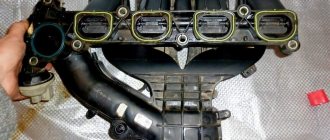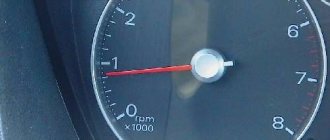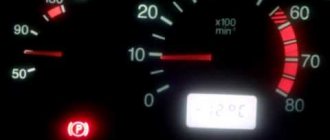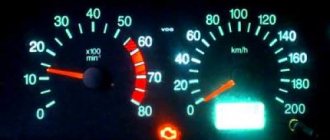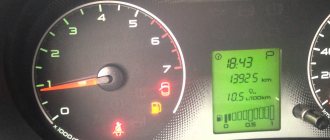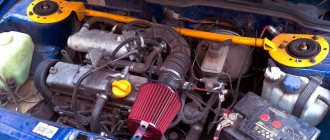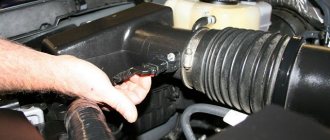You rarely see imported components on domestic cars. Basically, AvtoVAZ engines are equipped with a Solex or Ozone carburetor. Less often you can find products from the Dimitrovgrad Aggregate Plant, known for its reliability: the DAAZ carburetor. Drivers of relatively modern cars, accustomed to the check engine light, can easily determine any malfunction using an on-board computer or an inexpensive car scanner, but for veteran engine owners, only hardware diagnostics are available.
A common malfunction is idle speed floating, the main symptoms are:
- It would seem that the problem does not affect the speed - with intensive use of the gas pedal, the malfunction is invisible. However, it is dangerous in traffic jams, when the engine may suddenly stall, and when engine braking on a long descent;
- In addition, increased vibrations do not add life to the motor and attachments. Bearings of rotating shafts experience axial loads that are not typical for them. And it is uncomfortable for passengers to be in the car when the tachometer needle jumps from 500 to 1500 rpm.
The driver is forced to constantly apply gas, this distracts from the road and increases gas consumption.
So, manifestations of floating idle:
- The tachometer needle moves smoothly or sharply in the range of 1000 revolutions;
- The car shakes noticeably: there is always a feeling that it will stall;
- Pops of unburned fuel in the muffler and under the hood. In the first case, the mixture is rich, in the second, it is lean;
- Vibrations similar to tripping (at the same time you are sure that the spark plugs and the high-voltage part of the ignition system are in good condition);
- The motor randomly picks up speed, then smoothly reduces it. The problem is non-linear, it suddenly appears and also disappears suddenly (this somewhat complicates the diagnosis).
It is not difficult to localize the fault. If (we repeat: in the absence of other malfunctions), the speed fluctuates, look at the carburetor.
Niva injector wandering idle speed reasons
Hello!
Tell. I bought a new Niva 2131, a five-door car, and drove it in good condition for 2000 km. And suddenly one day I refueled and after a while the car loses power and the fuel needle drops down. The car started to shake, the engine seemed to want to stall. The revolutions are sometimes below 900 per hundred, then higher at XX. We thought it was bad gasoline, but believe me, we have been struggling with this reason for half a year and have not found out, it turned out that it was not the engine or the fuel system, the spark plugs and the damper looked like new.
There is a small assumption if you let me know about the generator, there is nothing more to think about and there is nothing to check - everything has been replaced - sensors, diagnostics without errors. Why a generator, because that time when all this happened, along with the fuel needle, the charging dropped from 14 to 9, all at the same time. The cooling fans also started turning on late.
One mechanic fixed this for me - because the ground was missing, he ran wires from the negative terminal to the engine and charging appeared and the fans started working on time. But at the same time, for some reason, the starter began to turn very quickly - faster than even when it was working properly.
But the behavior with the car and the jolts did not help. I read one story about an Opel with this reason, it turned out to have a generator, the generator seemed to take energy from the engine, I’m not an expert so I’m not very good at electronics.
The same thing happens here, according to his description, the car plays revs at idle and while driving, and the charging repeats after it, when you accelerate, the revs go up and immediately down, to 700, charge 10, and then the revs level off. 900, charge 14.
Also when starting, sometimes it catches right away, and sometimes it will turn quickly, but won’t catch until you give it gas, and this is with a new battery and car. If it spins quickly, it's not the battery. All this behavior occurs in exchange or when the car is shaken, when it drives well, and when it starts to struggle.
Tell me, maybe the generator is ruining everything, or it has nothing to do with it, the mass is cleared everywhere. I will be very grateful.
No gasoline
The culprits for the lack of gasoline may be:
There is simply no gasoline in the gas tank (this also happens), and therefore in the entire fuel system (fuel filter, pump, carburetor).
The fuel filter is clogged. This usually happens in the cold season, when moisture that gets into gasoline can clog the fuel filter. This can also happen due to dirt that could be drawn in from the gas tank.
The fuel pump does not pump. It's easy to check. The hose from the carburetor through which gasoline is supplied is pulled off and inserted into a small bottle. The assistant tries to start the car, we ourselves see if gasoline is pumped into the bottle, if gasoline is poured, then the gas pump is doing a poor job of doing its job. Why is it poor? Because we haven't tested the pump's performance. In the vast majority of cases this is not required.
Carburetor. After trying to start the car, remove the top half of the carburetor and see if there is gasoline in the float chamber. You can even check the gasoline level in the float chamber. Different models of carburetors will have their own. We need to clarify here.
The carburetor solenoid valve or the unit that controls it is jammed. We try to start with the gas pedal pressed to varying degrees, if there are attempts to start, then you can check it or temporarily screw in a non-working valve with a bitten off needle or a plug instead.
At one of these points, most likely, there will be a solution to the problem of the lack of gasoline in the combustion chamber. Next, you need to specifically pick the identified node.
The main reasons why the idle speed of the VAZ 21214 floats
The question of why the idle speed is floating is perhaps the most frequently asked question regarding the engine. Indeed, problems with idle are a common occurrence that car owners have to deal with.
The most unpleasant thing is not that this is very serious or that repairs will be too expensive and time-consuming, but that there can be a lot of reasons why the idle speed is floating. In this article I will try to help you find and eliminate the cause of unstable engine speed, so that you save your time and nerves.
Read more: Where is the wiper relay accent located?
Chevrolet Niva does not hold idle speed and stalls | Chevrolet
Why the Niva does not idle and stalls: the main reasons
The most difficult situation is braking down a hill. You need both brake and gas at the same time. Avoid such places. And so, you can fix it on the road.
The throttle position sensor does not keep the idle speed of the Chevrolet Niva 2. If your speed fluctuates while driving, and when you release the gas, the needle is in no hurry to return to normal speed, or it starts to move up and down, and this makes you ashamed to stand at a traffic light, because everything they think that you are a brainless shnivogonnik, accelerating from the traffic light and rushing. Then your problem is most likely in the throttle position sensor.
Both sensors are available for replacement.
The carburetor is adjusted, there are no other faults, but your engine speed still fluctuates
Next comes the search for real carburetor faults.
- Checking the idle speed solenoid valve. If you briefly apply power to it (by resetting and replacing the connector), you should hear a characteristic click. A faulty valve must be replaced;
- The float chamber needle valve is stuck. You will have to disassemble and wash the carburetor. If this does not help, the valve is replaced with a new one; it is impossible to sharpen or restore it at home;
- The idle passages or jets are clogged with debris. Flushing is required, preferably with the carburetor removed. A special detergent (such as “carbcleaner”) is used, then the channels are blown out with compressed air. A compressor will not work; it is better to use an inflated spare tire and a blow gun.
By and large, there are no other reasons for a floating idle associated with the carburetor. If after carrying out the above procedures, the problem remains, then this is a banal problem, with its own symptoms and causes.
The mechanical system for forming the fuel mixture requires literally surgical cleanliness of the internal components. Neglect of timely replacement of filters, as well as saving on matches (the cheapest gasoline in the area), lead to regular problems with the engine. However, eliminating them is not difficult - all you need is a simple tool and a steady hand.
If you have any questions, leave them in the comments below the article. We or our visitors will be happy to answer them
We are looking for the reason why the idle speed on the VAZ 21214 floats
Among other things, check the condition of the air filter; it may need to be replaced. Make sure that the ignition system is working properly and that there are no air leaks.
If the tips and recommendations described above do not produce results or you are not sure that you can cope with such work, seek help from professionals; specialists will quickly and accurately determine the source of the malfunction and stabilize the floating idle speed of the engine.
Thank you for your attention, I will be glad if it helps someone. If you know other reasons or methods of verification, you can safely add to this article using the comment form. Until we meet again, take care of yourself and your car.
If you find an error, please select a piece of text and press Ctrl+Enter.
I turned off the supply of crankcase gases going to the throttle to the throttle and everything seemed to be back to normal.
The engine does not hold idle speed well or stalls. The injector
Naturally, this takes into account external factors - speed, engine speed, temperature - and specified restrictions on the composition of exhaust gases. Also, the revs may fluctuate due to the vacuum tank, but most likely this is not the case. The same effect can be achieved by simply pressing the pedal for most of its travel.
Read more: What is vehicle type approval
The idle speed fluctuates and the engine does not run stably. what is the reason? Change sensor XX...
I start it up, it runs smoothly, but if I go for a drive, it starts to glitch, the speed stays and doesn’t drop until you turn it off and start it again. It is only important to remember that any node has its own resource, which exhausts itself over time.
Damage to the intake manifold.
The collector itself may also fail if the car has a sufficiently long service life. But more often the gasket fails. In this case, excess air is sucked in. To fix the problem, it is necessary to dismantle this part, as well as the units on which the injection elements are located. Before installing the gasket, it is necessary to thoroughly sand the surface of the manifold and clean it of traces of the old gasket. But it is important to remember that the occurrence of this problem is accompanied not only by increased idle speed. Damage to the gasket makes it difficult to start the engine and the speed fluctuates while driving.
As can be seen from practice, there are a very large number of problems that can cause increased idle speed on a warm engine. Therefore, if there are doubts that self-repair will not bring the desired result, it is better to entrust the car to specialists who, with the help of professional equipment, will be able to quickly identify the defect and eliminate it.
We carry out the adjustment ourselves
Niva 21213 can be subject to adjustment of the starting system by the gap at the edges of the valves, if the carburetor is removed, or by the crankshaft speed directly on the car. In the first case, the gap at the location of the lower edge (in the direction of air movement) from the throttle valve is set to a width of 1.1 mm. It is adjusted with a screw that has a 0.7 cm hexagon on the head and a slot from the shank. This operation is carried out with the cam lever turned counterclockwise from the starting system control (all the way). In the same position, the gap at the lower edge of the air damper is set to 3 mm using a screw in the cover from the diaphragm mechanism in the starting system (you need to loosen the lock nut). At the same time, the rod from the diaphragm must be forcibly recessed completely into the adjusting screw. After adjustment, the screw is fixed with a locknut.
Idling on a Chevrolet Niva
At the same time, the electronics takes into account a whole set of parameters: And in no case should you allow the vehicle to be operated with a part that has exhausted its service life. A universal device for diagnosing any car. In some Chevrolet Niva models, the idle speed may sometimes freeze when changing gears.
So, when the neutral is turned on, the speed does not drop below. The error must be looked for in the software of the car’s on-board computer.
And only flashing it in a specialized service can help. Do you still think that diagnosing a car is difficult? If you are reading these lines, it means you are interested in doing something in the car yourself and really saving money, because you already know that: Maybe someone has encountered such a problem.
I changed the throttle body and the throttle body and washed the throttle body. When moving in neutral, the revolutions do not drop, they stay in the area. You stop and the revolutions drop to When the fan is turned on, the revolutions also drop. Diagnostics show everything is normal. Did you put the throttle cable exactly in place?: It throttles on its own, yeah.
I had a Kalina - in Maymax there is such a street of Yunosti, a private sector, I drove along it with the clutch half depressed, the Kalina rows slowly, but I let the clutch slip and it digs, and so it goes, in general there are only meters of road there, well I dropped off the passenger and drove back half-stressed.
Read more: Changing the oil in a Skoda Fabia gearbox
About 10 minutes later, I drove halfway and the clutch began to smell sharply. I turned it off, started it up five minutes later and drove off - I pressed the speed a little and immediately went higher, but the wheels didn’t move, somehow I got out of that damn road at those speeds.
Then the asphalt, acceleration - the revs also go up, but the car does not accelerate. I stopped on the side of the road to smoke and think about the situation. After about 10 minutes I start it up and the car drives as if nothing had happened.
This is exactly the same situation that happened a couple of weeks ago. I sinned on the IAC, but why does the speed only hold when coasting, and when stopping it returns to normal? I read somewhere that this kind of bullshit can also come from him. As a result, I bought a new IAC - it’s easier to replace.
I changed it, the problem did not go away. I reset the battery terminal again. But yesterday I went to the car market to buy oil and thought about buying a speed sensor at the same time. This morning everything is fine too. Also, the revs may fluctuate due to the vacuum tank, but most likely this is not the case.
I changed the DMRV and the result was 0.
I changed the speed sensor 0. I turned off the supply of crankcase gases going to the throttle to the throttle and everything seemed to be back to normal. The engine needs to be repaired with excess crankcase gases directly to the bulkhead. How old is the ShNiv, how long is the mileage? Diversant old air flow sensor was covered in oil inside!? Today, at a friend’s house, I looked at how the crankcase gases from the absorber are approaching the throttle in the opposite direction.
Unstable idling niva chevrolet
To do this, you need to completely remove the throttle assembly and either replace it if damaged or clean it using special products. In this case, some models will require additional computer diagnostics.
This component most often fails because it is constantly exposed to high temperatures. Therefore, in some cases it is better to start looking for problems there. It is also checked using a multimeter. After replacement, the ECU may need to be cleaned for errors.
The collector itself may also fail if the car has a sufficiently long service life. But more often the gasket fails. In this case, excess air is sucked in.
The speed in the field 21214 injector floats
Good day to all!
A small problem appeared: the idle speed began to float, somewhere in the range of 1000 - 1200 revolutions. I started looking for the reason. First of all, I tightened all the clamps of the pipes suitable for the throttle block to prevent air leaks. It didn’t help. I replaced the idle speed sensor, and since I had to remove the throttle unit, I washed it thoroughly with ABRO carburetor cleaner. But this also did not solve the problem. I decided to change the throttle position sensor. From the factory, the car had a TPS from the Arzamas manufacturer RICOR. I've already driven 78,000 km. Not bad for this sensor. I decided to install a contactless sensor produced in KALUGA. ALL! The problem has disappeared. The motor worked like new. I read about this sensor on the Internet. People praise. The plant guarantees 250,000 km. I also liked the work of the sensor. The idle speed is stable. The idle speed sensor (also manufactured in Kaluga) costs 690 rubles. Throttle position sensor (TPS) -810 rub. Total 1500 rub.
Name: Yaroslav Reg.: 03/21/2012 Threads / Messages: 3 / 8260 From: Taganrog Age: 28 Car: VAZ-21214-50-120 (06/01/2012), SHTAT UniComp 400L (firmware 3.3.1), VAZ-11173 2012, VAZ-21112 2006
Reg.: 03/05/2009 Messages: 22 From: Sevastopol Age: 40 Car: 21214, 2008
Reg.: 12/06/2004 Threads / Messages: 4031 / 23190 From: Moscow Age: 65 Car: 21214M, 2013
If the throttle valve cable is not tensioned at xx (check!), then the IAC is most likely to blame.
But the check does not light up for all errors - set the BC and look at the error codes. Without this, you still won’t figure it out and will wonder what other sensor to replace. As a result, saving on bookmakers will backfire.
Alexey aka ALER.
Reg.: 03/05/2009 Messages: 22 From: Sevastopol Age: 40 Car: 21214, 2008
Reg.: 05/05/2013 Messages: 102 From: Tambov Age: 49 Car: VAZ 21214 2007
Reg.: 04/15/2014 Messages: 6 From: Moscow Age: 36 Car: 21214, 1.7i, 2002 Euro-2
Good afternoon. This is the first time I’ve asked for help on a topic; before this I figured it out myself - thanks to the forum. I have been driving the field for 4 years now, and for all 4 years in cold weather (sometimes) after a long drive the idle drops after releasing the gas. Not step by step, but sharply almost to zero, sometimes it stalled. I was guilty of frosting the remote control, cleaning always helped or improved the situation, but when in warm weather my speed began to drop to 500 or less and the consumption subjectively increased to 16 liters in the city, I decided to put the squeeze on the problem. I drove around with the recreation center turned off, it seems everything is the same, although it’s difficult to judge. IAC, of course, also changed more than once, I don’t think it’s him. What annoys me is that I drove the car 60,000 km (155 thousand km mileage), I changed the DC when I bought it - the old one almost burned my car. But the mass air flow sensor still stands and how long it took me to get there is unknown. The voltage on it is 1.04V when igniting, it seems like it’s time to replace it, but for some reason I don’t believe that it’s throttling the revs. An important point - my DC knew the taste of antifreeze - the gasket broke in the cylinder, drove like a locomotive for six months, then capital, which means he also grabbed oil during break-in. How does it even work after that? The catalytic converter is knocked out, the compression was 11 11 10.5 11 last time. There is enough power, the only question is the idle failure after a long load. You can, of course, change everything at random, but the budget is limited. Came in today with a laptop and took “cardiograms”. It feels like DK has become lazy and has started to freeze. Can anyone estimate the DK sine wave? There are 3 pictures here – XX, 3 thousand. rpm, reset from 3 thousand. to XX. Here at the reset there is a suspicion that the DC is leaning the mixture. I don’t rule out leakage, I haven’t checked it yet, I’d like to hear advice from like-minded people. PS Sorry for writing a lot, but the whole picture is visible. Change the DC valve and/or mass air flow sensor? PPS I love my car - I won’t sell it to anyone))) Thank you!
Idle: (Air flow – 12-14kg/hour)
3000 rpm: Reset from 3000 rpm. to xx:
Pensioner
Specialist
We brought this device in today for diagnosis with the complaint “the engine runs in waves” I.e. The tachometer is in place, but there is uneven rotation. First of all, new spark plugs, wires, and checked the compression. Everything is okay. I didn't find any air leaks. I took out the forces, did the balancing - everything is ok here too.
According to the scanner, the readings: after starting everything is as if it were in the textbook, as soon as the lambda starts working and the SOP immediately begins to change in waves: from -20 to 5 degrees. pkv.
Factory firmware B120ER19
In which direction should I pick?
Sergo33
Guest
Expert
Rakso
Oscar
There was a similar case, but the sausage at XX (as if you were riding on a tram) began exactly at 90g.
after the fan was activated, it stopped for a couple of minutes.
Uoz also jumped, up to -19 degrees.
everything was checked, just like the pensioner
. rrx put a new one - the same eggs.
I noticed that if you raise the speed to 1000 or reduce the px steps to 28-30, everything returns to normal.
I consulted with some forum members and decided that it was hydraulics.
I'm not a mechanic and I didn't want to do anything with the engine, because... I was going to sell the stroller.
did it at about 1000 rpm. then I talked to Pasha - he sent me some medicine - the rpm is 800 and it doesn’t wobble))
To do this, the engine warms up to operating temperature. Then just check the sensor using a multimeter. If it malfunctions, you must replace it with a new one.
This component is responsible for the amount of air mixture entering the engine combustion chamber. If the sensor is not configured correctly, the fuel supersaturated with air will detonate more strongly, spinning the engine faster and increasing speed. The sensor can also be checked using a multimeter.
Chevrolet Niva does not hold idle speed and stalls
You just need to wait until the engine cools down so as not to burn your hands. The replacement itself is simple, unscrew the old one and screw on the new one.
The electrical connector there is such that you can’t connect it crookedly. When you first start the engine, the speed usually goes up. But, if you turn it off and start it again, the engine will work properly. Of course, there are other reasons for unstable engine operation, but finding problems there is more difficult. In any case, it is better to replace the sensors first. Basically, the problem here lies in a clogged throttle valve.
Factors influencing floating speed
When you turn on the car, the engine warms up quickly to reach the optimal temperature . After which, using the electronic control unit, the speed is reduced to normal values. When for some reason the unit does not work, you need to find out the cause of the malfunction.
Increased intensity of engine operation leads to disastrous results - thermal shock, malfunction in the cylinder block, accelerated depreciation.
When the idle speed fluctuates in a Chevrolet Niva with an injector, the reasons may be as follows :
Another possible problem is a malfunction in the electronic control unit.
Main reasons
When starting, the engine can reach higher speeds to warm up faster. This manifests itself especially often in winter. But after some time, after reaching the minimum operating temperature, the electronic control unit is activated, which reduces the engine speed to normal. If this does not happen, then it is urgent to look for the reasons causing this problem.
Higher speeds indicate more intense engine operation, which can lead to a wide variety of consequences. Long-term operation may cause the engine temperature to rise significantly, resulting in thermal shock. This will cause problems in the operation of the cylinder block. In addition, most components will experience heavy wear and tear due to unstable engine operation and, as a result, accelerated wear. All this will affect the service life of the engine.
Therefore, it is necessary to immediately figure out what reason caused the increase in speed. There are several of them:
- idle speed sensor
- throttle sensor
- Problems with throttle angle adjustment
- failure of the engine temperature sensor
- air entering through a damaged intake manifold
- problems with the electronic control unit
We are looking for the reason why the idle speed on the VAZ 21214 floats
Among other things, check the condition of the air filter; it may need to be replaced. Make sure that the ignition system is working properly and that there are no air leaks.
If the tips and recommendations described above do not produce results or you are not sure that you can cope with such work, seek help from professionals; specialists will quickly and accurately determine the source of the malfunction and stabilize the floating idle speed of the engine.
Thank you for your attention, I will be glad if it helps someone. If you know other reasons or methods of verification, you can safely add to this article using the comment form. Until we meet again, take care of yourself and your car.
Didn't find the information you are looking for? on our forum.
Diagnostics of DXX
Often, problems with the idle air control valve are confused with a breakdown of the throttle position sensor . A distinctive feature is that the “Check Engine” indicator on the dashboard lights up in the event of a failure of the throttle position sensor.
The following signs indicate a breakdown of the idle air regulator::
If at least one point matches, it is necessary to check the DXX.
To check the functionality, measure the voltage supplied to the regulator :
If the regulator is faulty, it is replaced with a new one.:
The new device is assembled in the reverse order.
VAZ 21213 4WD 3 doors. SUV, 76 hp, 5 manual transmission, 1977 — engine speed jumps at idle
contents .. 949 950 951 ..Engine speed jumps (floats)
Floating idle speed is a fairly common malfunction on various cars. The revolutions fluctuate on gasoline cars and diesel units, as well as on engines with gas equipment. Note that the idle speed on gas or gasoline fluctuates quite often due to third-party incorrect ECU firmware. While driving, this problem can cause a lot of inconvenience, since the driver is forced to constantly apply gas to prevent the engine from stalling at the most inopportune moment. Next, we will look at why the engine speed jumps at idle, as well as how to determine the cause of the problem for further elimination.
Unstable idle speed: reasons
Normally, idle speed on different engines can fluctuate in the range from 700 to 900 rpm. It should be taken into account that immediately after starting a cold internal combustion engine, the control unit increases the idle speed, forcing the engine to operate in the so-called “warm-up mode”. This mode is normal, that is, it is not a malfunction. After reaching a certain temperature and slightly warming up the engine, the “warm-up” speed drops, and the engine begins to operate in normal idle mode.
If the engine speed jumps at idle, then this malfunction looks like lightly pressing and releasing the gas pedal, and the driver himself does not press the accelerator. In other words, the idle speed may be too high or normal, then begin to drop to the point where the engine almost stalls. After this, the engine “picks up” again, the needle on the tachometer rises again and the jumps in the form of increasing and decreasing speed are repeated. Typically, the malfunction appears for several minutes, often on a cold engine, after which it disappears until the next start. It is also possible that the breakdown is present constantly and regardless of the degree of engine warm-up, that is, the speed constantly fluctuates after the gas pedal is released and the internal combustion engine switches to idle mode.
There are many reasons for such unstable idle. Among them there are several main ones. First of all, it is necessary to take into account the type of engine installed and its power system: carburetor, injector, diesel engine.
On engines with a carburetor, most problems are solved by cleaning and adjusting the specified metering device.
The engine idle speed on the carburetor must be adjusted, since the settings tend to get lost during active operation of the vehicle. You should also pay attention to ensure that the fuel-air mixture does not become significantly depleted in the carburetor. The carburetor solenoid valve deserves special attention. A characteristic sign of its breakdown is the engine’s refusal to idle without choke. It is also necessary to exclude the possibility of air leaking into the carburetor, which can also greatly lean the mixture. As a result, the engine stalls, the speed jumps, and the engine begins to stall. When manipulating the carburetor, you should check the degree of contamination of the jets, clean the idle passages, assess the fuel level in the float chamber, etc. The ultimate goal is a normal supply of air and fuel to the carburetor, as a result of which the mixture composition will be optimal for the idle mode. During operation, carburetor jets require periodic cleaning; at the same time, you need to check the condition of the air filter and replace a heavily contaminated element.
Now there are several reasons why the speed jumps on an injection engine. As you know, modern cars with such an engine are equipped with electronic fuel injection controlled by the ECM. Such a control system is structurally equipped with many sensors, thanks to which the composition of the fuel mixture is determined in different operating modes of the internal combustion engine. It is quite obvious that failure or erroneous data from any sensor can lead to floating idle speed. In other words, the electronic control unit (ECU) does not receive reliable information or receives data intermittently, resulting in the speed jumping at idle. The list of possible malfunctions should include:
Ignition and problems with this system. It is necessary to check high-voltage wires, spark plugs and other elements. Inlet. Malfunctions in the intake may be associated with the mass air flow sensor, a dirty air filter, or air leaks. Idle speed regulator. Failure or malfunction of this device naturally leads to unstable engine speed at idle. Exhaust gas recirculation system USR. Problems with EGR cause disturbances in the composition of the fuel-air mixture, which also affects the stability of engine speed. If the speed fluctuates at idle, then checks should begin with the IAC. The location of the regulator is usually the area next to the throttle position sensor TPS. You can check the specified device by replacing it with a known good one or using a multimeter. To check with a multimeter, you should find out the operating resistance, and then measure the resistance of the regulator with a tester. Deviations from the norm will indicate a possible breakdown of the idle air regulator.
If the regulator diagnostics show its operability, then the test should be continued. The next element is the mass air flow sensor DMRV. To check, you should disconnect the power connector from the mass air flow sensor, after which you need to start the power unit. In idle mode, the speed can rise to about 1200-1500 rpm. Stable operation of the internal combustion engine with the mass air flow sensor disabled and improved acceleration dynamics while driving will indicate that the speed may fluctuate due to problems with the mass air flow sensor.
As for the EGR valve, this solution allows some of the exhaust gases to be returned back into the intake. This was done to improve the environmental performance of the internal combustion engine. In other words, the valve opens and then closes the passage to send exhaust back into the engine. Failure or “sticking” of the valve leads to excess exhaust gases entering the intake, affecting the mixture composition, idle speed and other engine operating modes. For normal operation, the EGR valve must be cleaned periodically, especially its seat. A diesel engine is structurally different from a gasoline engine in that it contains a fuel injection pump. For this reason, floating idle speed can occur both as a result of problems inherent in gasoline analogues, and as a result of problems with the high-pressure pump. For example, corrosion or mechanical wear of moving elements inside the pump. Jams and other failures lead to the idle speed of a diesel engine jumping.
The list of main systems and mechanisms that need to be checked in case of floating speed at XX includes:
-intake system; -supply system; -ignition system; -gas distribution mechanism; -exhaust gas recirculation system;
Each of these systems requires detailed diagnostics. It is also necessary to take into account that heavily contaminated injection nozzles or a break in their supply circuit can cause floating speed, loss of power, engine tripping, exhaust smoke, etc.
For this reason, the injector must be promptly cleaned of contaminants (every 30-40 thousand km traveled) by washing or removing deposits in an ultrasonic bath. You should also pay attention to the performance of the fuel pump and the pressure it creates in the fuel rail. Contamination of the fuel pump mesh is a common cause of unstable engine operation, jumping speed and other malfunctions. Finally, we add that in some cases, engine tripping and malfunctions at idle and under load are accompanied by the fact that a “check” lights up on the dashboard. Note that fixing the error and recording the fault in the ECU memory can make troubleshooting easier. To determine the failure or malfunction of a particular sensor, it will be enough to connect a special scanner to the vehicle’s diagnostic connector to read error codes and then decipher them.
Specifications
Technical characteristics of VAZ 21213 4WD in a 3-door body. SUV with a 76 hp engine, 5 manual transmission, produced since 1977.
Basic data
- Start of production:
January 1994 - End of production:
January 2007
- Body:
3 doors SUV
Engine
- Engine type: L4
- Fuel grade: AI-92
- Engine capacity, cubic meters see: 1689
- Valves per cylinder: 2
- Supercharging: no
- Power, hp: 76
- Achieved at vol. per minute: 5200
- Torque, Nm/rev. per minute: 125 / 3000
- Maximum speed, km/h: 137
- Acceleration time to 100 km/h, sec.: 19
- Fuel consumption (combined cycle), l. per 100 km: 11.2
- Fuel consumption (in the city), l. per 100 km: 11.5
- Fuel consumption (outside the city), l. per 100 km: 8.3
- Engine layout: front, longitudinal
- Power system: carburetor
- Gas distribution system: overhead valve with overhead camshaft
Drive unit
- Drive type: permanent all-wheel drive
Transmission
- Transmission: Manual
- Number of steps: 5
Suspension
- Front: wishbone, transverse stabilizer, coil spring
- Rear: push rod, Panhard rod, coil spring, telescopic shock absorber
Brakes
- Front: disc
- Rear: drum
Dimensions
- Length, mm: 3740
- Width, mm: 1680
- Height, mm: 1640
- Wheelbase, mm: 2200
- Front wheel track, mm: 1430
- Rear wheel track, mm: 1400
- Ground clearance, mm: 220
Other
- Number of seats: 5
- Tire size: 175/80 R16
- Curb weight, kg: 1210
- Permissible weight, kg: 1610
- Fuel tank volume, l: 42
contents .. 949 950 951 ..
Idling on a Chevrolet Niva
At the same time, the electronics takes into account a whole set of parameters: And in no case should you allow the vehicle to be operated with a part that has exhausted its service life. A universal device for diagnosing any car. In some Chevrolet Niva models, the idle speed may sometimes freeze when changing gears.
So, when the neutral is turned on, the speed does not drop below. The error must be looked for in the software of the car’s on-board computer.
And only flashing it in a specialized service can help. Do you still think that diagnosing a car is difficult? If you are reading these lines, it means you are interested in doing something in the car yourself and really saving money, because you already know that: Maybe someone has encountered such a problem.
I changed the throttle body and the throttle body and washed the throttle body. When moving in neutral, the revolutions do not drop, they stay in the area. You stop and the revolutions drop to When the fan is turned on, the revolutions also drop. Diagnostics show everything is normal. Did you put the throttle cable exactly in place?: It throttles on its own, yeah.
I had a Kalina - in Maymax there is such a street of Yunosti, a private sector, I drove along it with the clutch half depressed, the Kalina rows slowly, but I let the clutch slip and it digs, and so it goes, in general there are only meters of road there, well I dropped off the passenger and drove back half-stressed.
About 10 minutes later, I drove halfway and the clutch began to smell sharply. I turned it off, started it up five minutes later and drove off - I pressed the speed a little and immediately went higher, but the wheels didn’t move, somehow I got out of that damn road at those speeds.
Then the asphalt, acceleration - the revs also go up, but the car does not accelerate. I stopped on the side of the road to smoke and think about the situation. After about 10 minutes I start it up and the car drives as if nothing had happened.
This is exactly the same situation that happened a couple of weeks ago. I sinned on the IAC, but why does the speed only hold when coasting, and when stopping it returns to normal? I read somewhere that this kind of bullshit can also come from him. As a result, I bought a new IAC - it’s easier to replace.
Problems with throttle travel
These problems are similar to the breakdown of the TPS and entail the same consequences . A distinctive feature is that the problem is not in the electronic part, but in the degree of contamination of the part itself with oil vapors, waste combustion products, or due to the long-standing replacement of the air filter. If contamination is detected, the throttle assembly is removed and cleaned using special cleaners or replaced if damage is found.
Attention! After cleaning, the DS angle is often set incorrectly due to a “memory effect” in the electronic control unit. In such a situation, some models require additional computer diagnostics.
Why does the Chevrolet Niva experience increased idle speed on a warm engine?
All car enthusiasts sometimes face such a problem as high idle speed. But, unfortunately, it takes a beginner a significant amount of time to find and fix this problem without visiting a specialized car service center. To do this, you will need a detailed manual that will specifically describe all the necessary actions.
Main reasons
When starting, the engine can reach higher speeds to warm up faster. This manifests itself especially often in winter. But after some time, after reaching the minimum operating temperature, the electronic control unit is activated, which reduces the engine speed to normal. If this does not happen, then it is urgent to look for the reasons causing this problem.
Higher speeds indicate more intense engine operation, which can lead to a wide variety of consequences. Long-term operation may cause the engine temperature to rise significantly, resulting in thermal shock. This will cause problems in the operation of the cylinder block. In addition, most components will experience heavy wear and tear due to unstable engine operation and, as a result, accelerated wear. All this will affect the service life of the engine.
Therefore, it is necessary to immediately figure out what reason caused the increase in speed. There are several of them:
Ways to solve problems
Diagnosing this problem requires some knowledge as the process can cause irreparable damage to the engine. Therefore, you must carefully read the operating instructions for this car. It is also important to remember that Chevrolet Niva cars are equipped with injection-type gasoline engines, so increased idle speed on a warm engine is most likely caused by the electronic components of the car.
Checking the idle speed sensor
To do this, the engine warms up to operating temperature. Then just check the sensor using a multimeter. If it malfunctions, you must replace it with a new one.
Throttle position sensor
This component is responsible for the amount of air mixture entering the engine combustion chamber. If the sensor is not configured correctly, the fuel supersaturated with air will detonate more strongly, spinning the engine faster and increasing speed. The sensor can also be checked using a multimeter.
Problems with throttle valve travel.
These problems are similar to the failure of the throttle sensor and lead to the same consequences. Only the main problem here is not electronic - but contamination of the damper itself by oil vapors coming from the crankcase, combustion residues, or due to rare changes of the air filter. If there are traces of contamination, the damper must be cleaned. To do this, you need to completely remove the throttle assembly and either replace it if damaged or clean it using special products. It is important to remember that after cleaning, the throttle valve angle may be incorrectly set due to the so-called “memory effect” in the ECU. In this case, some models will require additional computer diagnostics.
Engine temperature sensor.
This component most often fails because it is constantly exposed to high temperatures. Therefore, in some cases it is better to start looking for problems there. It is also checked using a multimeter. After replacement, the ECU may need to be cleaned for errors.
Damage to the intake manifold.
The collector itself may also fail if the car has a sufficiently long service life. But more often the gasket fails. In this case, excess air is sucked in. To fix the problem, it is necessary to dismantle this part, as well as the units on which the injection elements are located. Before installing the gasket, it is necessary to thoroughly sand the surface of the manifold and clean it of traces of the old gasket. But it is important to remember that the occurrence of this problem is accompanied not only by increased idle speed. Damage to the gasket makes it difficult to start the engine and the speed fluctuates while driving.
As can be seen from practice, there are a very large number of problems that can cause increased idle speed on a warm engine. Therefore, if there are doubts that self-repair will not bring the desired result, it is better to entrust the car to specialists who, with the help of professional equipment, will be able to quickly identify the defect and eliminate it.
Why the speed fluctuates - localization of the fault
First, you need to cut off potential sources of the problem close to the carburetor.
- Let's leave the fuel supply alone. It (gasoline) is either there and the engine is running, or it is not there and there is no problem with idling (as well as the engine itself);
- A potential culprit is a clogged engine air filter. The main cause of uneven idle is air, or rather oxygen, so we inspect the first obstacle in the way of oxygen especially carefully. If you changed the filter at the end of spring, it may be clogged with June poplar fluff. Regular trips on primers, or clouds of dust donated by the “coaters”, coke the pores of the filter element within a month. It happens that a low-quality product from “homemade” ones from the Middle Kingdom simply breaks into shreds and clogs the carburetor throttle assembly with scraps. In any case, let's start by checking the filter;
- The diametrically opposite reason is excess oxygen. The intake tract of an internal combustion engine is relatively sealed. All incoming air flows are carefully calculated by engineers. In injection systems there is a mass air flow sensor, and the ECU can adjust the mixture parameters depending on the oxygen flow. The carburetor has only a mechanical setting for a certain volume. Any unauthorized air leak causes floating speed. The filter breaks, the valve cover gasket breaks, or the carburetor seal leaks - and unaccounted for (and also dirty) air goes into the chamber. The leak can be on the fittings of the vacuum tubes and on the crankcase ventilation system.
A less common cause is the housing or diaphragm of the distributor vacuum regulator. That is, the device responsible for the stable operation of the power unit is itself the cause of the malfunction.
If none of the listed reasons are found, we will inspect the carburetor. Moreover, no special equipment, much less electronic devices, is required.


